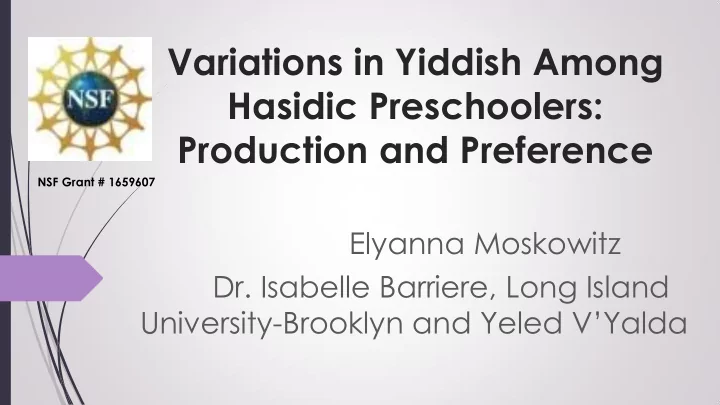

Variations in Yiddish Among Hasidic Preschoolers: Production and Preference NSF Grant # 1659607 Elyanna Moskowitz Dr. Isabelle Barriere, Long Island University- Brooklyn and Yeled V’Yalda
Introduction Yiddish: language originally used by Jewish people in Eastern and Central Europe. Yiddish shares structural elements with other Germanic languages and also incorporates elements from other languages, including Hebrew, Aramaic, Slavic and Romance languages. It is written with the Hebrew script.
Yiddish in NYC Yiddish ranks 7 (between French and Korean) among the most spoken Languages Other Than English in NYC (US Census Bureau, 2010). 85,341 Yiddish speakers in NYC over 5 years old Different varieties of Yiddish in contact with one another in NYC, including different varieties of Hassidic Hungarian and Polish Yiddish in Brooklyn – which are understudied compared to other LOTEs (e.g. Spanish) (Peltz 1990; Barrière, 2010; Peltz & Kilger , 2013).
Yiddish in Brooklyn CD1 - Population Change 1990-2000 8,000 6,000 4,000 2,000 0 -2,000 Yiddish Polish Chinese Spanish -4,000 -6,000 -8,000 Fast Increase (30%) of Number of Speakers
Background Connection between people’s social relationships and their use of language: much more studies on adults than children Nardy et al.’s (2014) study : the evolution of children’s accent (L1 French) in relation to the number of interactions with classmates and teacher, as well as the evolution of children’s accent in accordance to standard accent. Results: verbal exchanges that preschool children have with classmates have an impact on the everyday use of standard and non-standard dialect in French; limited effects of teachers; differences between boys (more non-standard) and girls .
Purpose The sociolinguistics of bilingual Yiddish-English children This study combines the essence of Peltz’s research on spoken Yiddish in NYC and Nardy et al.’s study on children’s social relationships and language usage into one study that features the variation in the use of Yiddish among preschoolers.
Hypothesis We expect children’s preference to be based on and affected by the dialect of their parents , teachers , and peers .
Participants N = 14 4-5 years old Enrolled in YVY Early Childhood Center Head Start Program no Individualized Education Plan/Special Needs or hearing loss Dominant Hungarian Yiddish and/or Polish Yiddish-speaking home; few differences between the two varieties Attending class with peers from both linguistic backgrounds
Differences between Hungarian and Polish Yiddish: vowels, r, a few fillers and function words , prosody Polish Yiddish Hungarian Yiddish B o bi zugt ‘ zaye r git ’ B a bi zugt ‘ zaye r git ’ Grandma says ‘very good’
Differences between Hungarian and Polish Yiddish: vowels, r, a few fillers and function words , prosody Polish Yiddish Hungarian Yiddish Oy , d u s iz nish git! Yoi , d ei s is nisht git!
Methodology 1 Preference Task- Matched Guise: Verbal Stimuli- Sentences produced by the same speakers with different accents (Polish or Hungarian Yiddish) played twice Matched with videos of Male Puppets/Boys, Female Puppets/Girls on different sides of touch screens- moving when they ‘speak’ Randomization of the order of stimuli, the side of Polish-Yiddish and Hungarian- Yiddish speaking puppets, and the matching with colored background Children asked to select the one they prefer
Methodology 2 3. Story elicitation: Children presented a picture book on a biblical story and will be asked to tell the story. 4. Single word elicitation in group setting: Children will play the game Headbanz with peers (using same or different dialect) elicitation of the same words, to facilitate the identification of possible dialectical differences.
Methodology 3 Interpersonal relationship: Children assigned each classmate a smiley face if the child likes that classmate; a frowny face if the child does not like that classmate; or a placid face if the child is indifferent about that classmate (adapted from Nardy et al., 2014).
Results 1: varieties of the parents and teachers ( qu’aire ) Mothers Fathers Teacher Assistant P= Polish; Teacher H= Hungarian; O= Other 6 Girls P 0 P 1 P 6 P 0 H 3 H 1 H 0 H 6 O 3 (2 P+H, 1NA) O (2 P+H, 2NA) 8 Boys P 3 P 2 P 0 P 0 H 1 H 2 H 8 H 8 O 4 O (1 Russian Y, 3NA)
Results 2: Preference no preference Polish Yiddish Hungarian Yiddish
Results 3: Girls versus Boys Polish Yiddish Girls Hungarian Yiddish Boys
• Do the varieties they prefer reflect the variety of…. …..their parents (which ones? - mother or father)? …..the education professionals (teachers or assistant teachers)? …..and/or their peers (classmates)?
Results 4: variety of their parents, education professionals or peers/classmates? Issue: many parents were not clear about the variety they speak 4/6 girls prefer variety of their mother’s (incl. 2 also their father’s) 1/6 prefer variety of the teacher 2/8 boys prefer the variety of their mother (incl. 1 also their father’s) 1/8 prefers their father’s variety 1/8 boy prefers variety that neither reflects their parents or the education professionals but it reflect their peers’ variety (?) Limitation of Relation between Head-Banz games and Interpersonal Relations scale: most children like all their peers (difference between French and US/YVY preschool Contexts)?
Contributions First study on dialectal variation in Hassidic Yiddish-speaking preschoolers Development and use of a new ‘puppet matched guise paradigm’ to explore dialectal differences adapted to pre-schoolers Can be used to explore dialectal preferences in other languages Relationship Scale: not as useful as in Nardy et al (2014) Similarities with Nardy et al (2014) results: - Little effect of Education Professionals on Children’s Preference - Gender Effect, re: relation between Preference and Mother’s Variety more common in Girls than Boys (?) Follow up: Larger group and less homogeneous classrooms Consideration of different varieties: relevant to Educators and Speech- Language Pathologists (Difference versus Disorder)
Special thanks to: Head Start Professionals, parents & children! Katsiryana Aharodnik, YVY Research Institute lab manager NSF Grant # 1659607
Recommend
More recommend